Search: Clearing The Ruck
Maul and Ruck - Clearing the Ruck
Clearing the tackle area with pace relies on committed support. Clearance rucking is a dynamic method of restarting the attack if the defence has managed to create a breakdown.
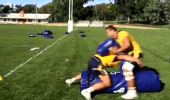 8:10
8:10
Ruck Clearing and Decision Making
Advanced clearing exercises for senior players. The support player makes a decision on how to clear out the ruck based on the position of the opposition.
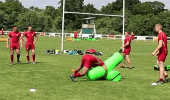 4:55
4:55
Ruck Clearing Exercises
Two crucial clearance techniques - the saddle roll, and the duck and clean. It's important for players to practice these at length, under pressure, under fatigue, and with an element of decision-making in order to best re-create a match situation.
To watch over 2500+ videos join now for free!
JOIN NOW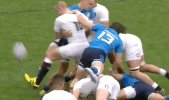 3:27
3:27
Breakdown - Clear & Kick
Teach your players how to kick the ball at the ruck. With players sometimes reluctant to give away penalties this technique is a great way to turnover the ball and stay on your feet
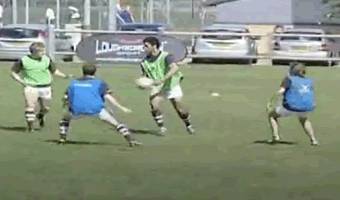 4:30
4:30
Small-side game - Ruck Touch
There are many versions of ruck touch with the support players needing to recognise the needs of the tackled player.
The defence should be conditioned to provide increasing pressure to the tackle area. This will develop the situation recognision of the attacking players who must play accordingly. Robotics in rucking regardles of the situation should be discouraged and the option of picking upthe ball and going forward should be an option
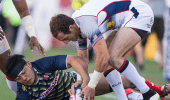 2:18
2:18
USA Sevens - Learn The Rules Of The Ruck
With less players the breakdown is much cleaner in Seven's and knowing the laws and being accurate in your skills wins matches. Mike Friday clarifies what can be a complex area and why many coaches focus on this facet of the game
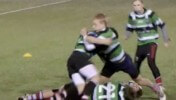 3:31
3:31
Ruck touch - Focus on rolling players away
A key technique at the breakdown is the ability to roll players away, this applies when your opponent already has a good body position over the ball. Danny Wild from Leeds carnegie uses a game and breakout sessions to deliver his session
Maul and Ruck - Under 13s and 14s Ruck
Training through traditional drills does not develop game understanding and players often become robotic in their behaviour
Conditioned games promote game understanding and encourage players to recognise the needs at any given situation
The drill should be used only to refine technique and the danger is to develop players that act without game understanding
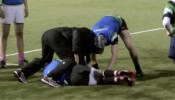 1:49
1:49
Decision making at the breakdown - Ruck touch
Coaching players to make the right decision at the breakdown is a complex challenge for coaches. In this video Danny Wild from Leeds carnegie uses a whole - part - whole approach to help improve the players decision making
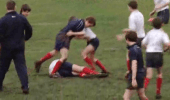 2:17
2:17
Ruck Touch Rugby
Coaches can use games to introduce all skills for your age group. If you are very specific about the conditions you apply then players will learn these skills in a fun and enjoyable game
3. Ruck Touch
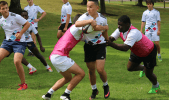 4:43
4:43
Rucking - Live With 5
A clever and competitive practise using 5 players that involves passing, tackling and then making the crucial decision of what to do at the breakdown. This can be done from Under 12's upwards
QBE - Ruck Touch
Maul and Ruck - U9 Coaching
Notice how these players do not naturally set up rucks. Both teams try to keep the ball away from breakdown situations.
What would these games look like if the coaches stepped in and insisted on rucking?
Maul and Ruck - Maul Gain Lines
With the maul, the gain line is fluid and the defence can be forced onto the back foot
With the ruck, the gain line is static and the defence are often set and on the front foot
Maul and Ruck - Under 10s and 11s Mauling
Notice how the tackled player often remains on their feet and a mass of pulling and pushing begins
When a player is taken to the ground, the supporting players try to pick the ball up. There is not a natural inclination to ruck
 0:42
0:42
Junior - Accurate clearing of players 1
Junior - Accurate clearing of players
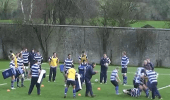 1:00
1:00
Rucking Zone
A tiring exercise of continuous rucking. Encourage your players to maintain good standards even when tiring and highlight the importance of getting straight up after one breakdown to make another.
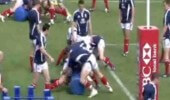 1:03
1:03
British Lions - tackle then Jackal then clear out
Many of these drills require repetition, here we see how the importance of good body shape in contact can be practiced as both the jackler and those clearing out the tackle
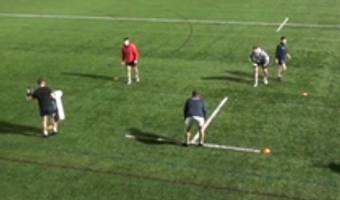 1:06
1:06
Contact Square - Inside Clear
All attacking players need to fix their opposite defender.
 3:14
3:14
The Importance of Basic Breakdown Skills
Continuously we see that the best teams are those that perform the basic skills better than their opponents. Basic skills such as passing, catching, running, tackling, and rucking. The breakdown is an essential element to the game as teams look to control momentum. Mastering the basic rucking and clearing techniques gives many teams the edge, and the quick ball that is required to enable their attack.
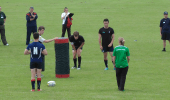 1:27
1:27
Turnover session - Clearing
Breaking down the turnover situation into separate technical elements, players can work on their essential skills.
Here, in a series of progressions, the emphasis is on the first defender to arrive at the breakdown. They should attack the breakdown and fight to get through and past the ball.
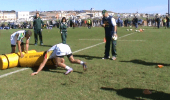 2:06
2:06
Breakdown - Accurate Rucking
This series of clips shows how conditioning and good technique are crucial to be effective at the breakdown. The progressions are simple and the key coaching points are Low to high body position Strong leg drive Accuracy on the target - The tackle bag

Women's - Accurate clearing of players 1
 1:13
1:13
Fitness - Reptile crawls for rucking
Fitness exercises to help players improve their effectiveness in contact are very popular at present. Jack Crehan talks through this exercise and demonstrates how it should be done
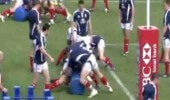
British Lions - tackle then jackal then clear out
This technique proved so successful they adjusted the rules to prevent its use, what was the rules change and can you coach it?
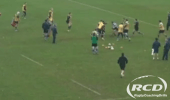 1:03
1:03
Fringe Attack - Pop and Ruck
Attacking close around the fringe can minimise risk of losing the ball and can help turn slow ball into quick ball, putting the defence on the back-foot.
Maul and Ruck - Maul Leg Drive
Staying on the feet and maintaining aggressive leg drive, can be very difficult to defend
Maul and Ruck - Practice Relevance
Consider the relevance of each practice
Make practices as realistic to the game as possible in order to maximise the learning process

Men's - Accurate clearing of players 2
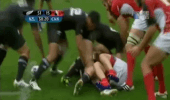
Men's - Accurate clearing of players 1
Maul and Ruck - Maul Slide Drive
In this technique, the ball is constantly being shifted so the point of pressure is moving and challenging the defence
Maul and Ruck - Misunderstanding the breakdown
Training through traditional drills does not develop game understanding and players often become robotic in their behaviour
Conditioned games promote game understanding and encourage players to recognise the needs at any given situation
The drill should be used only to refine technique
Materiality Clip 9 - Backfoot at Ruck
Maul and Ruck - Practice Relevance
Consider the relevance of each practice
Make practices as realistic to the game as possible in order to maximise the learning process

Women's - Accurate clearing of players 2
Maul and Ruck - Spin Maul
The spinning or rolling maul is an effective weapon when executed at speed. Notice what happens to the pace of the attack when the ball goes to floor with a breakdown

Women's - Accurate clearing of players 3
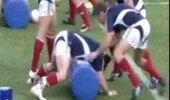 0:47
0:47
Lions 09 - Clearing the tackler away
With the new adjustments around the tackle zone, what variation would you adopt now so that this drill is now legal?
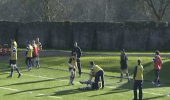 0:51
0:51
Support play in 3s, Offload and ruck
Practice the different options in recycling the ball. A lot of the time, the ball will be tied up and an offload won't be on. Develop this drill by allowing the players to call how the ball should be played, and for their teammates to react.
Materiality Clip 11 - Ruck Management

Sevens - Accurate clearing of players 2

Sevens - Accurate clearing of players 1
Maul and Ruck - Youth Maul
The maul can be a fast method of retaining the ball. It commits more defenders. It can continue to gain ground. The dangers are when forwards and backs are separated in practice and the back-line players do not understand their role at the maul, or even back away from the contest.

Junior - Accurate clearing of players 2
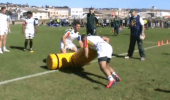 2:02
2:02
Breakdown - The Saddle Roll Technique
This clearing technique is used to remove defenders who have latched onto the ball and are in a low body position. Coaches can vary the angle that the clearers approach from
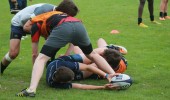 2:25
2:25
Coaching the Breakdown
The battle for the breakdown can decide matches. There are many elements that make up a solid breakdown, including ball presentation, speed of support and effective rucking technique. Log in to RugbyCoachingDrills to see video tutorials from top coaches and players.
 2:46
2:46
L2 - Support Line Breaks & Offloads
Skill Practice Description • The game begins with touch tackles. • Once tackled the ball carrier is allowed to step beyond the tackle line and the support from either side run toward (or attack) the ball. • The pass must be delivered behind the tackle line and not put back in front of the defence, so speed and decision making is vitally important. • Develop the game to grip tackles below the rib cage so the ball can be off loaded. • Progress to full tackles and the ball carrier must fight to keep the ball available. • The support must be aggressive in attacking the ball and getting between and beyond defenders. • When in full contact and the ball carrier cannot off load immediately, rucks and mauls may be played. Key Coaching Points • The game relies on good support play in all areas. This game illustrates the need for consistent and aggressive support. • The supporting players need to work for the ball carrier and attack the ball, getting in behind the defence for an off load. • Once the tackle line has been breached the attack must not allow the defence time to reorganise. • When progressed to full contact, the demand on decision making increases
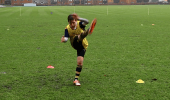 6:00
6:00
Techniques needed to box kick
Elite coach and player go through the skills required to box kick. There are three main steps and some recommended practises with some added competition to help improve
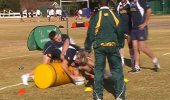 0:55
0:55
Breakdown - Grip and Roll (Saddle)
The grip and roll clearing technique, (Known as saddle clearing to some) is a technique to use when defenders have already established a strong position over the ball. Using brute force will probably fail so approaching the defender slightly from the side and using the clearers momentum he grips and rolls the player away
 5:25
5:25
Breakdown - Using games to coach
Academy coaches use conditioned games with strict rules around the tackle / touch activity to teach the skills required for contact and clearing defenders away. Questioning is used as the main style of coaching
 5:13
5:13
Ball Retention Techniques
Progressions are used to build the technical competency and the confidence of players learning to clear defenders away from the contact area. It is interesting to see that no contact shields are used
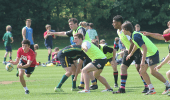 6:10
6:10
Fringe Defence at the Breakdown
Building a defensive system starts with the first three defenders and what they need to do at the breakdown. The Northampton saints coaches go through the steps and progressions to help younger players learn the key movements and techniques
 2:16
2:16
Worcester - Decision Making
The coach uses a tackle sausage and ball to replicate an attacking player. If the player falls back towards the defender he secures the ball, if the attacker falls further away the defender clears aggressively. This exercise could be worked as a support player for one of your own attackers
 7:27
7:27
Defence - Defensive Systems
This clip shows past footage, but from this bird’s eye view, it clearly illustrates the organisation required to be a sound defensive team
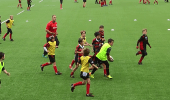 6:12
6:12
New Rules of Play - Under 10s - Coaching Points
This video provides some detailed coaching points that the Saracens community coaches would recommend age groups coaches focus on in their sessions
 3:32
3:32
Geech - Coaching Philosophy
Sir Ian provides an insight into the famous British Lions tour in 1997 and how important it is to have a clear philosophy. This ground breaking tour still has fundamentals that apply today
 1:01
1:01
JWC 2012: Forwards Passing
At the JWC 2012 is was clear that more forwards were passing the ball.
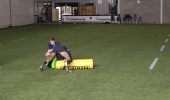 1:20
1:20
Worcester - Breakdown decision making
The coach progresses a static decision making exercise into a moving one. The coach uses a ball strapped to a tackle sausage to replicate attackers and where they may be tackled. The defenders then have a decision to make, either jackal on the ball or clear opponents
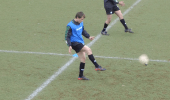 3:57
3:57
Learning to grubber Kick
A series of technical exercises and games to coach the grubber kick. The coach is clear in his explanations and uses questioning with his players to reinforce the key points. The games include some fun moments
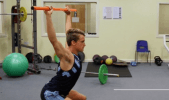 2:40
2:40
Techniques for squatting
Getting techniques right for using weights is the first thing that should be practised and mastered as part of any strength & conditioning program
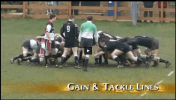 0:51
0:51
Game Understanding - Gain line & Tackle line
It is important that the players and the coach have a common understanding of where the gain line is, from a set piece and also from a ruck or maul. This is often not fully understood and may influence the success of both attack and defensive objectives. It is also important to understand where the tackle line might be, as this will impact on the strategy and alignment of the back line.
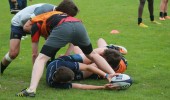 0:59
0:59
Ball Retention Principles
Two of the key principles of ball retention are the efforts of the tackled player to present the ball, and the decision of the support player, to bridge, ruck, or recycle. Log in to find complete sessions on the relevant techniques.
 6:44
6:44
Coaching tackle technique & progressions - Mini
Coaching tackle technique never stops. As players get older, the challenges become more complex and coaches need to provide more detail to improve the finer skill sets. This video provides some expert tips that may help you improve tackle technique and the first phase of the ruck / breakdown.
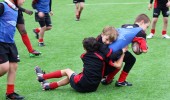 6:35
6:35
New Rules of Play - Under 9s
The new rules have completely changed the focus for under 9's. Tackling technique, progressions and games to promote tackling are the main themes for this age. No rucks, scrums or line outs to worry about
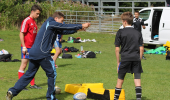 4:14
4:14
Scrum Half Passing with Chris Cusiter - Wrist Warm-Up
Sale Sharks and Scotland scrum half Chris Cusiter leads a session on passing from the base of a scrum or ruck. In this first video, Chris addresses basic technique in a couple of exercises that warm up the wrists and arms.
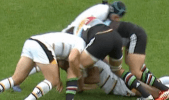 5:56
5:56
Bouncing - The key to contact skills
Encouraging players to improve their "Floor" skills is the key to improving contact skills such as tackling, rucking and competing for the ball. It might be simple but it is effective
Coaching Process-DEMONSTRATION
Its important to remember that most people are visual learners.
Even when your instructions are clear, reinforce the understanding with a demonstration.
Avoid whenever possible doing the demonstration yourself as you cannot see that you are correct.
Position so all can see and hear
Focus attention on 1 – 2 key points
Invite questions and check for understanding
You may need to repeat the demonstration, particularly for those involved initially, as they have not seen it
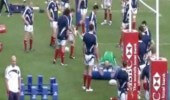 1:01
1:01
British Lions - tackle then jackal
It is important to practice not only the body shape of the defender but also those doing the clearing out of the defender
Performance Analysis - Analysis Sequence
There is clearly a handling error in the midfield, but from where might this orignate?
Scrum Factory - 2. Tower of Power Demonstration
Good body posture is essential and applicable to all players regardless of age and gender
This posture transfers to the tackle, ruck, maul and in a vertical plain the lineout, so it is important that all players are coached to adopt good posture in contact
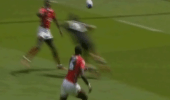
Sevens - 2 v 1
A variety of passes create a 2 v 1 which is executed perfectly for the outside attacker to score. Key factors : Different angles of running and support - Comunication - Ball presentation - Effective clearing of defenders at the breakdown - Accurate wide passes - Attack the inside shoulder of the last defender - Flat spin pass
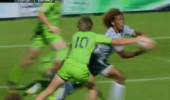 1:11
1:11
IRB 7s - Single Phase Tries
The 2011/12 Sevens World Series saw an increase in the number of tries scored with no rucks or mauls in their build up.
 3:53
3:53
Coach Player Rapport
Do you understand the significance of 'Rapport" and how this can influence how good a coach you are. Elite coaches, experts and pundits provide a clear view of how important this is
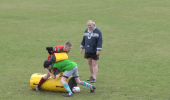 6:38
6:38
Breakdown - Coaching Players To Make Decisions
The coach uses a combination of drills & games to deliver a session on making decisions at the breakdown. There are some technical points and observations on the coach using classic "Tell & Yell" instructions
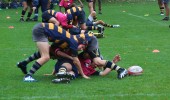 9:20
9:20
Managing the Contact Area
Concentrating on the actions of the tackler and the support player in the moments after a tackle. It's important to practice the correct body position and technique so that the right decision can be made on the pitch.
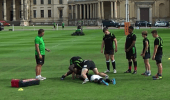 5:51
5:51
Turning defence into attack
The Northampton saints approach to defence is to "Turn over ball" and to this end the tackle is only the start of the process and the coach outlines this approach and provides some examples
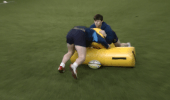 3:16
3:16
Worcester Academy - Clearout Techniques
Worcester Academy - Clearout Techniques
 4:43
4:43
Games or drills ?
The coaches explain why they use games and provide examples of how they deliver a session using games with technical skills as the basis for learning
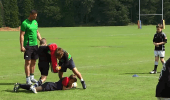 7:02
7:02
Breakdown Skills for Mini age groups
Introducing contact and breakdown skills to younger players can be a challenge for many coaches, in this clip the Northampton saints community coaches explain some of the technical points and use some simple practises to help them learn
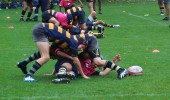 1:17
1:17
Coaching the breakdown
Looking at fundamental breakdown skills to manage the contact area. Log in to see the full session
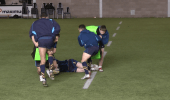 2:46
2:46
Worcester - Live breakdown work
A further progression for players to make decisions with multiple attackers and defenders on what the 1st and 2nd player does at the tackle
 5:51
5:51
Games for Coaching - Examples
Coaches often request ideas to help them plan sessions. Here are some examples of the conditions that coaches can apply to make training more challenging and enjoyable
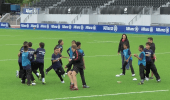 5:51
5:51
Agility Games for contact warm up
Saracens community coach uses games and competitive activities to introduce the contact elements of rugby. This builds confidence in players prior to actual contact skills
 4:11
4:11
Expert - John Neal - Teams
John Neal discusses the attributes that make an effective team.
 1:45
1:45
Expert Conor O Shea - what makes an effective team
Conor O SHea discuss what makes an effective team
 3:31
3:31
Defence Policy - What Is It?
Richard Thorpe has been a professional player for a decade and is now an RFU level three coach. He see's defence as the key to success and in this clip explains what "Defence policy" means
 2:48
2:48
Stay Positive at Training
Win or lose, it's important to focus on the positives to maintain confidence in your players and a productive training environment.
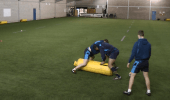 1:48
1:48
Worcester Academy - Clearout Technique Exercise
Worcester Academy - Clearout Technique Exercise
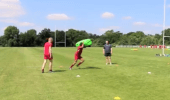 4:17
4:17
Technical Fitness with Tackle Bags
Tackle bags are a great tool to use in your conditioning sessions. The reduced impact allows players to peform high repititions of contact technique under fatigue, with low risk of injury.
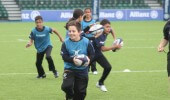 4:41
4:41
Coaching the breakdown with games
The challenge of using games to coach contact is a tricky one for many coaches. This clip shows the Leeds carnegie academy coach explaining how to integrate games into his coaching and the different styles of delivery
 4:13
4:13
Breakdown - The race for space
The battle to dominate the breakdown is often the difference between winning and loosing. This area of the game is always changing so coaches need to regularly learn new things and challenge their players
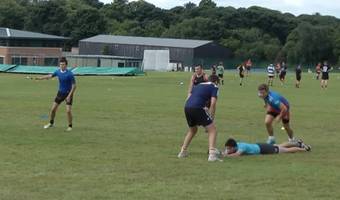 3:44
3:44
Ball Presentation Game
Use this game to practice great ball presentation. Ensure the tackling player is bouncing back to their feet so that this mentality carries over to game day.
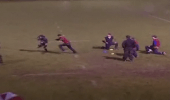 4:15
4:15
Back Row Defence
Back Row Defence
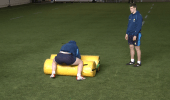 1:43
1:43
Worcester Academy - Jackal Technique
Take a look at how they coach the jackal technique at Worcester academy!
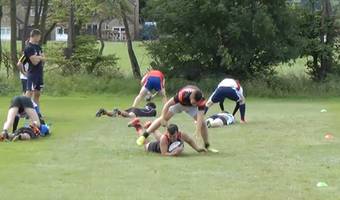 3:26
3:26
Quick Ball Presentation Drills
Use these quick and competitive games to practice good and strong ball presentation. Practice with high standards and it will come naturally in the games!
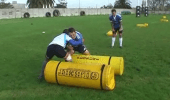 1:36
1:36
Breakdown Skills - Progressions
 1:15
1:15
Interview - Conor O Shea priorities
 3:46
3:46
Blitz Defence - Its simple If You Know How
When the experts explain things in simple terms it all makes sense. The Blitz defence can be confusing and delivering the coaching blocks to develop this policy can be tricky. Richard Thorpe explains things in easy to understand language
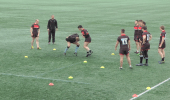 3:55
3:55
Games for coaching Contact
The coaches use a variety of conditions for both the attackers and defenders to reinforce the coaching points. Small sided games enable players to learn in a live environment similar to actual match conditions

